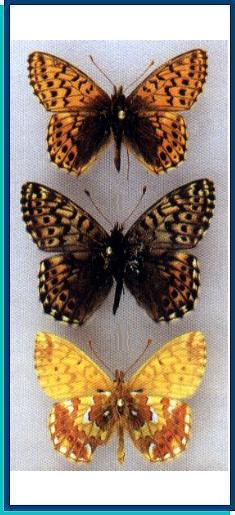LEPIDOPTERA
N Y M P H A L I D A E Swainson, 1827
BOLORIA Moore, 1900
Boloria alaskensis (Holland. 1900)
Boloria alaskensis (Holland. 1900)

• TYPE LOCALITY, "...mountains between Forty-Mile and Mission Creeks» [Alaska, USA].
• RANGE. Tundra from the Polar Urals to E. Chukotka; N. America from Alaska to the North Territories of Canada.
• DISTRIBUTION AND VARIATION. The Polar Urals and Yamal Peninsula are inhabited by the ssp. sedykhi Crosson du Cormier, 1977; the nominotypical subspecies occurs to E. Chukotka and Wrangel Island in the east; from the mountains of N. Transbaikalia, the ssp. bato Churkin, 1999 (TL: Kodar Mts., Chita Region] has been described.
• TAXONOMIC NOTES. When validating "Argynnis arsilache f. (subsp.) nikolajewski B.-Haas i. 1.", Heydemann (1920: 271) has failed to indicate a type locality. Crosson du Cormier (1977) has allocated nikolajewski (Heydemann, 1920) to B. alaskensis, yet expressing doubts concerning the provenance of type material from the Nikolaevsk-on-Amur District. Until now, B. alaskensis remains unknown from the Amur region and adjacent parts. The male labeled as "nikolqjewskr, deriving from Zhigansk, Yakutia and figured in Warren (1944: pi. 33, figs. 186 & 187) evidently belongs to B. alaskensis. The type locality "Nikolaevsk-on-Amur" is thus likely to be erroneous, probably mistaken for Nikolaevsk-Kamchatsky, as there is no other place name "Nikolaevsk" in E. Siberia and the Far East. If so, then the taxon nikola-Jewski (Heydemann, 1920) is a synonym of alaskensis Holland, 1900. To finally solve the problem, a study of sufficiently abundant material from different parts of E. Siberia and the Far East is necessary.
• HABITATS AND BIOLOGY. Lowland or mountain tundra up to 1,500 m a.s.l. Flight period: Juny to August. Host plant (Henriksen & Kreutzer, 1982): Polygonumsina viola.
• SIMILAR SPECIES. Boloria banghaasi: ground colour of UPS brighter, ochre-red; by colouration females poorly distinguishable from males; HW without acute prominence with a top at vein M3. B. purpwea: UNS with reddish suffusion; wings more angular; spot between veins Cui-Cu2 not separated from the cell.
Photo and text: Guide to the BUTTERFLIES OF RUSSIA and adjacent territories Volume 2. PENSOFT, Sofia - Moscow. 2000